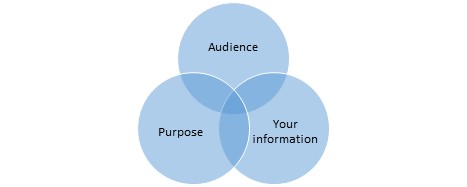5 Chapter Five: So What? Creating a Thesis Statement

Once you have a topic figured out along with your audience and purpose, and you’ve come up with some content, you need to decide what point you are trying to make about that topic. That’s the basis of a thesis statement. It’s the “So what?” of your topic. This “So what?” is present in any kind of writing: formal papers, essay question responses, emails, presentations, social media posts, proposals to clients. Every piece of writing needs a point.
Getting Started: Thinking about the Thesis Statement
In a paper, a thesis tends to be more formal and is ideally one complete sentence, defining the “So what?” of the paper.
For example, let’s say your topic is about difficulties high school students have when filling out the FAFSA (Free Application for Student Financial Aid) when they want to go to college.
So what?
What are you going to say about this topic? This might lead you to think about audience and purpose again.
Possible Audiences
- Are you writing to high school students who have divorced parents?
- Are you writing to high school students who are without a lot of parental support?
- Are you writing to students whose parents aren’t native English speakers?
- Are you writing to high school advisors?
- Are you writing to the officials who administer the FAFSA?
Possible Purposes
- To inform on the most recent changes in the process?
- To give a simplified “how to” based on your experiences?
- To show how to avoid common errors?
- To give encouragement in what is a complicated process?
- To argue for specific changes in the form or application process?
Once you figure out your audience and purpose, then you can start thinking of your thesis.
So, let’s say your audience is a group of high school students who have divorced parents. Your purpose is to help them navigate communicating to their parents the requirements of the FAFSA.
Next, you can go back to your exploring and look for information, examples, evidence, and research that you collected. You might need to go back and look for more now that you really know your focus.
Finally, write a working thesis. “Working” means it’s a draft:
Sample Working Thesis
Students with divorced parents need to develop a strategy for communicating with both parents in order to get all the information needed to complete the FAFSA form and be eligible for college financial aid.
That’s a good start! As you continue throughout the writing process, your thesis will most likely change to fit the information and ideas that continue to develop.
Elements of a Good Thesis Statement
So, what makes a good working thesis? Ask yourself two major questions:
Is it Interesting?
Is it specific?
What makes a thesis statement interesting?
Being interesting doesn’t have to mean the writing is about mutant zombies who become cheerleaders for a professional football team (although that would be interesting!). The question to ask is “To whom is this interesting?” This means making sure your thesis is relevant to your audience. Is it meaningful? Can the audience connect to it or can you make them connect to it? For example, maybe your topic is worm composting. You decide your audience will be a local gardening club because the topic is interesting and relevant to that population. Your thesis, then, would draw more on how to make the topic interesting to that audience.
Maybe you are given an audience and purpose. You have a write a report and present it to your class and your purpose it to teach them something about the class topic (American Literature). You would want to find a topic that interests you and your audience and then create a thesis that will engage the audience as much as possible.
Sample Working Thesis
By using Americana music and Jazz rhythms, the poets of the Harlem Renaissance changed American poetry and made it more relevant and accessible to many people, especially people of color.
Sometimes, your audience is your nursing instructor or a client at work. Then you need to think about what their expectations are. You also need to think about what you know or what you can learn (through research). Find the intersection between those two things, and you will have a good thesis.

What makes a thesis statement specific?
Having a specific thesis means making sure your topic fits your writing assignment. Is it too broad or too narrow? Does the thesis fit the assignment or writing project? A thesis for an email to a potential employer, for example, needs to be focused because emails should be short and to the point:
Example of email focused thesis
I want to thank you for the opportunity to interview with St. Joseph’s Hospital, and I am including the additional information we discussed yesterday.
Short, to the point. The rest of the email, then, would discuss this additional information.
Keep in mind that when writing a thesis, it’s very easy to go too broad:
Example of a thesis that is too broad
This essay will discuss social media’s impact on young people’s mental health.
Whoa! That’s way too big. People have written whole books on this topic! First of all, what is considered “young”? Which social media platform? What kind of essay will this be (informative? persuasive? cause and effect?)? Who is the audience? All of this will help you to limit your thesis and topic.
But you also need to be careful not to go too specific either. What about this thesis statement?
Example of thesis that is too specific
Facebook is no longer popular with teenagers.
This is essentially a fact. There could be an additional sentence proving that statement using research, but there isn’t anywhere else to go with that statement. How about this one?
Another example working thesis
The newest social media app developers claim to have made their platforms more user-friendly for teenagers, but they are just as damaging to mental health as the older platforms. This is a solid thesis statement. When you read it, you’re left with several questions:
- What are these new social media platforms? What are the older ones?
- What are the developers of the new platforms actually saying?
- How do they impact mental health, and how is the writer going to prove it?
Though you have questions, you also have a clear direction of where this essay is going. That’s a great sign that you have a solid thesis statement.
Using Thesis Statements to Stay Organized
Sometimes thesis statements give away the structure of the essay by listing not just the WHAT, but the WHY.
For example, the following is a good thesis:
Thesis with a What
College students should take online classes.
It is focused, and it is arguable. It says WHAT should happen. We can take it a step further, though, by adding the WHY:
Thesis with a What and a Why
College students should take at least one online class because it will make their schedule more flexible, teach them important technologies, hone their time management skills, and make them better online writers.
Ah ha! After the “because,” we have a list. That list not only answers why college students should take online classes, but those are also the topics for the body paragraphs that follow. Based on this thesis, we know that we’re going to read about these things in order in the rest of the essay:
Online classes make schedules more flexible,
Online classes teach students important technologies,
Online classes hone time management skills, and
Online classes make students better online writers.
There will be four paragraphs, and they will be in the same order as presented in the thesis statement. It’s handy to keep you organized as the writer, and it also helps the reader understand what they’re getting into with your essay.
Where Does the Thesis Statement Go in the Essay?
Generally, the thesis should be in your introduction, often toward the end of it, often the last sentence. This allows you to introduce the topic, give context to the subject and then narrow to your specific thesis, your what and why.
Keep in mind that once your thesis statement is given, everything in the body of the paper should be focused on supporting and developing it—nothing should go beyond it. That’s why you may sometimes need to rewrite your thesis several times as you are drafting and revising.
Quick Tips for Writing a Thesis Statement
Key Takeaways: Thesis Statement Qualities
- Is one complete sentence (and not a question).
- Focuses on a single main point about the topic.
- Is specific.
- Is something you can show, explain, or prove.
- Is a forceful statement written in confident, firm language.
A Formula for a Great Thesis
A good formula for creating a thesis statement looks something like this:
Narrowed subject + Controlling idea = Thesis statement
Example #1 of Thesis Formula
Narrowed subject: Local farming
Controlling idea: Support helps improve health and the economy
Thesis statement: Supporting local farmers by buying their produce helps improve our personal health as well as boosts the local economy.
Example #2 of Thesis Formula
Narrowed subject: Romantic relationships in high school
Controlling idea: Aren’t worth the time and effort
Thesis statement: Pursuing a romantic relationship while in high school is not worth the time and effort because it ultimately distracts from what are the most important parts of being a teenager: being successful in school, pursuing hobbies, and growing platonic friendships.
Example #3 of Thesis Formula
Narrowed subject: Shampoo ads
Controlling idea: Selling more than beautiful hair
Thesis statement: The two shampoo ads for Herbal Essences and Pantene are selling beautiful hair along with the idea that using these products will help create satisfying romantic relationships.
Still not sure if what you have is phrased well? You can think of it this way: a thesis should fit well into the following blank: “In this essay I say, ‘______.’” But don’t use that phrase in your thesis–just say it!
Resources
“Developing Strong Thesis Statements.” Purdue University OWL, 2025, https://owl.purdue.edu/owl/general_writing/academic_writing/establishing_arguments/index.html.
“The Thesis Statement.” Capital Community College Guide to Grammar and Writing, 2004, https://www.guidetogrammar.org/grammar/composition/thesis.htm.
“Tips and Examples for Writing Thesis Statements.” Purdue University OWL, 2025, https://owl.purdue.edu/owl/general_writing/the_writing_process/thesis_statement_tips.html.
Media Attributions
- artist and easel © Designed by pch.vector / Freepik
- Audience purpose information venn © Amy Jo Swing
A sentence that states the main point or argument of your essay.
